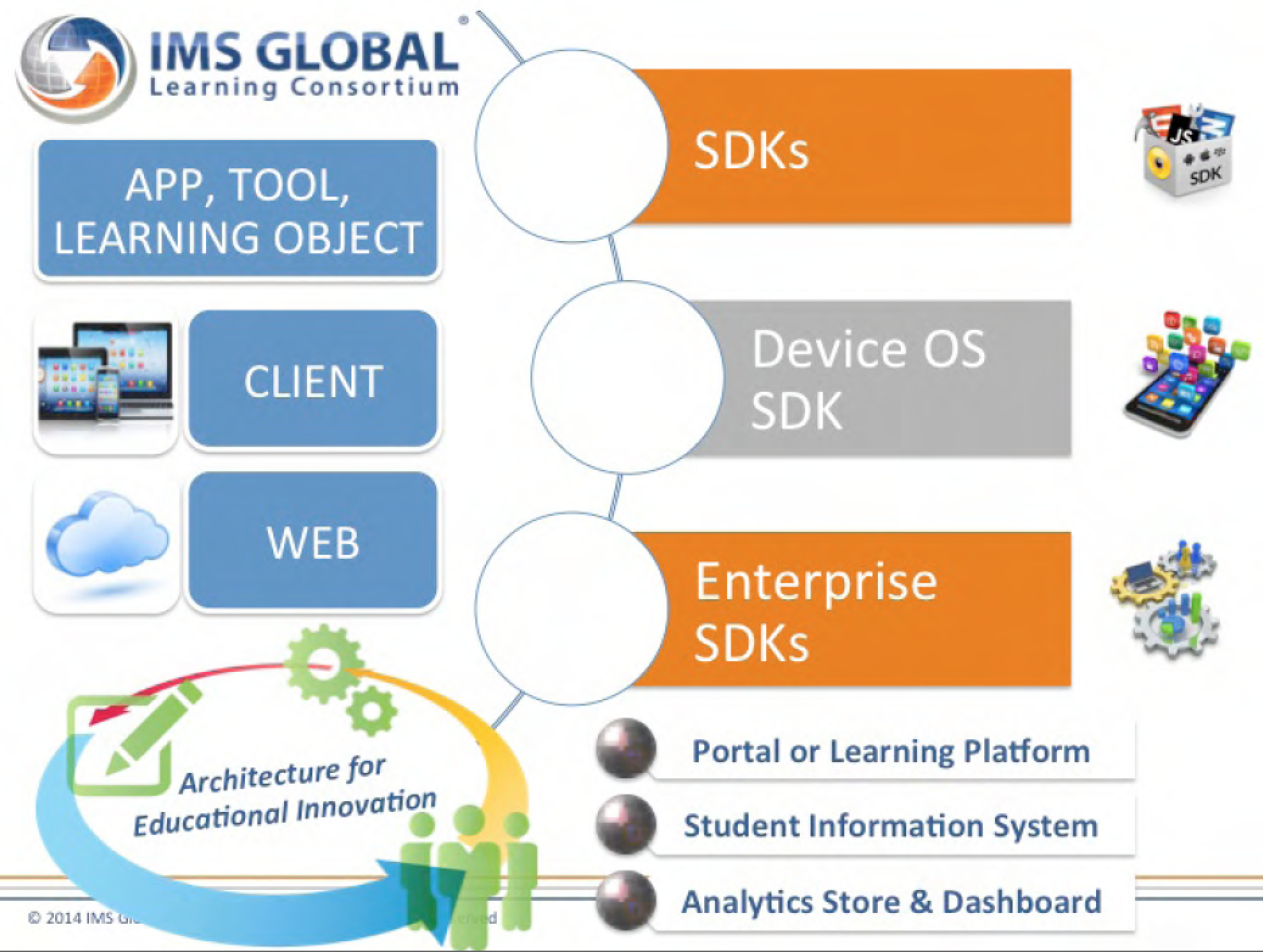“Alignment” is especially challenging in the world of higher education. Alignment of interests and direction is very difficult to achieve within a university structure, which have evolved to what Clark Kerr termed as the “Multiversity” (a collection of diverse communities under one umbrella).
Alignment, it would appear, should be even more challenging across universities. However, there are forces at work, for instance community interaction via organizations like EDUCAUSE. Indeed, some theorists have postulated that independent institutions evolve to very similar structures not through “top down” leadership but more through practitioner community effects (a theory known as institutional isomorphism). So, in practical terms, one of the reasons why most CIOs at colleges and universities seem focused on similar priorities is because they all talk to and influence each other via groups like EDUCAUSE.
For almost a year now 1EdTech has been talking about something we call “an architecture for educational innovation.” What we mean by that is a community owned, developed and supported set of interoperability standards that make educational applications plug and play with each other and thus allow the focus/investment to be primarily on innovative apps rather than infrastructure. This concept started achieving clarity in the Abel, Brown, Suess EDUCAUSE Review article from October 2013, A New Architecture for Learning.
1EdTech does not bring all the things needed for the architecture to materialize: Far from it. 1EdTech brings one small but absolutely critical piece, which is an organization via which institutions and suppliers can co-create, evolve and sustain the required interoperability (call them standards if you like – but ease of interoperability is what is required, versus standards per se). Organizations such as Internet 2 bring the cloud-based infrastructure that is so critical to offloading the infrastructure concerns. Organizations like EDUCAUSE Learning Institute and the larger EDUCAUSE bring the leadership needed to make it happen.
Here are my (admittedly subjective) take on some of the notables from EDUCAUSE in priority order (most important first), with the relevance to beginning alignment toward an architecture for educational innovation:
- Unizin: The first of it’s kind consortium among large R-1 universities to enable sharing of content and data announced adding several new members. This is a very serious effort, reflected by the $1 million membership fee for each university, and at the heart of this effort is reliable and efficient interoperability to enable the sharing regardless of what products are used.
- EDUCAUSE Next Generation Digital Learning Environment (NGDLE): A new, potentially well-funded effort (sponsored by the Gates Foundation) to envision and take tangible steps toward enabling a more comprehensive view of what today would be the learning management system (LMS). It is clear from the focus group of 50+ leaders that occurred at #edu14 that interoperability and the flexibility and access to data needed to improve instruction is clearly among the top three enablers for this effort. And, this interoperability will go well beyond the LMS (which despite its many detractors is typically the most open and interoperable system on campus today).
- Diana Oblinger: Diana received numerous well-deserved recognition at what will be her last EDUCAUSE as CEO per announced 2015 retirement. Diana has turned out to be a great fit for EDUCAUSE CEO, leading an enormous rise in stature over the last six years. However, the real news item here is that during Diana’s tenure EDUCAUSE revenues of more than doubled to over $35 million annually. How many commercial product suppliers have had that level of success during the same period? As with the prior two bullets regarding Unizin and NGDLE this success can be interpreted as increasing leadership from the institutions in driving the direction of technology.
- Campus Computing Survey: Once again “assisting faculty with the instructional integration of information technology” was ranked most important. The future of educational IT is not about “locking the faculty down” – it is about enabling better, more innovative instruction.
- Kuali project: There was hubbub at EDUCAUSE about this well-known open source ERP project adding a commercial spin-off which included questions about what would remain open source. In the architecture for educational innovation diversity and innovation go hand-in-hand. This includes (very importantly) diversity of business models. We see the evolution of Kuali as just one more example of the need to find a path that leads to sustainable innovation. If you’d like everything with respect to education to be free, then please begin with your own salary.
- Mobile-first products: In the last few weeks, including at EDUCAUSE, I’ve spoken with at least five suppliers relatively new to the education space, touting their “mobile-first” strategy – meaning the solutions were built from the ground up to support mobile devices as the primary interface with the ability to work well in the “consumer world” of diverse platforms, apps, etc. How this consumer world interoperates with the more closed world of educational systems and institutions is a problem that requires agreed upon interoperability to address enable at scale. There is great opportunity for those organizations that can work with 1EdTech to begin to plug some of these gaps – and it is beginning to happen.
- Gartner Group: Albeit not released at EDUCAUSE, Gartner’s July report on the Hype Cycle for Education covers something called “Exostructure Strategy” – leveraging interoperability to enable more friction-less partnering - whose description includes several 1EdTech standards as the enabling technology – as having transformational potential. Since Gartner has had literally zero interaction directly with 1EdTech, it is clear that this is a trend that their institutional and supplier members are telling them about.
- University of Central Florida: We were blown away by UCF’s LTI app development work – and their leadership in getting the message out on how institutions can and should be realizing the architecture for innovation/exostructure strategy!
What do you think? Beginning of alignment toward an architecture for educational innovation? Here are the intro slides from our 1EdTech panel session on the topic.















